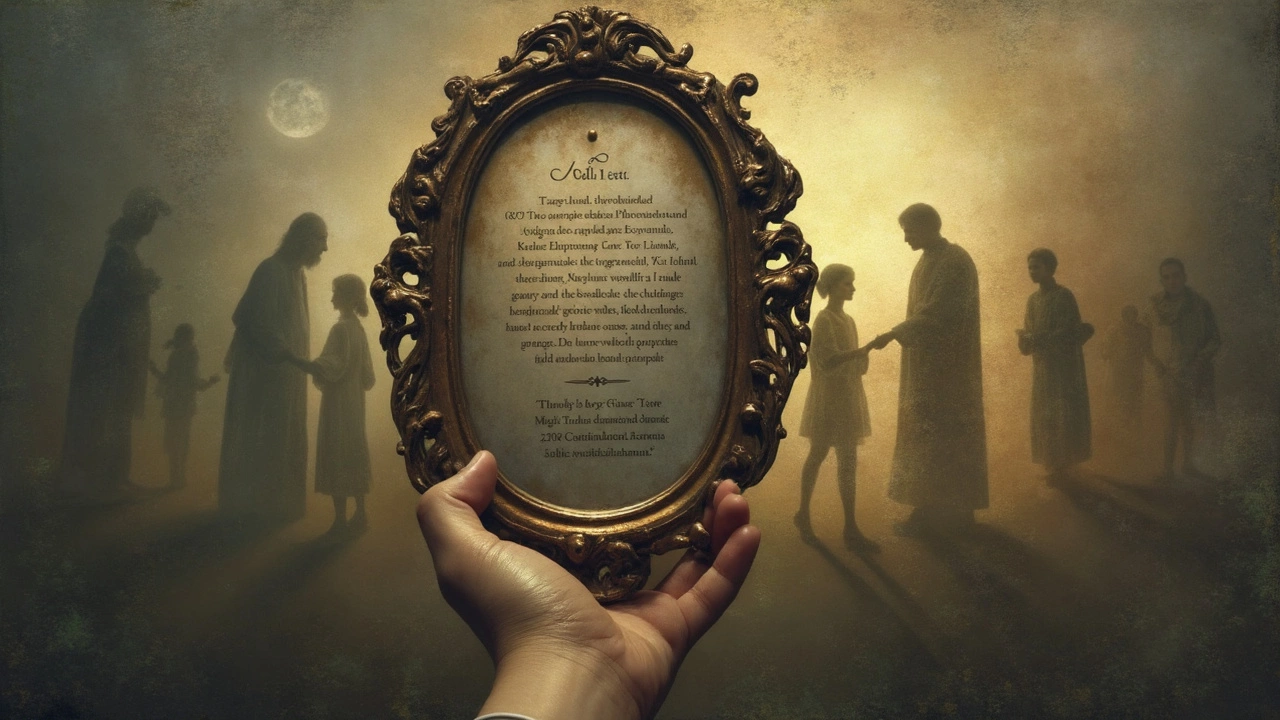If you’ve ever wondered whether the Bible even mentions mirrors, you’re not alone. Today, mirrors are everywhere—we use them for makeup, shaving, checking our outfits, or snapping selfies. Back in ancient times, mirrors were kind of a luxury, and not everyone had one lying around. They were nothing like modern glass panes, but usually made from polished bronze or copper. No crystal-clear reflection—just enough to check if your hair was messed up.
But here’s a funny thing: when you look for the word "mirror" in most English Bibles, it pops up only a handful of times. Still, those verses pack some meaning, and they even point to bigger spiritual ideas—for example, how we see ourselves or how we think about inner growth. So, figuring out what the Bible actually says about mirrors can reveal more about how people saw themselves (literally and figuratively!) thousands of years ago.
- Mirrors in Ancient Times
- Actual Mentions of Mirrors in the Bible
- Symbolism: Mirrors as Metaphors
- How Early Christians Viewed Mirrors
- Interesting Facts About Biblical Mirrors
- Reflecting Today: Lessons You Can Use
Mirrors in Ancient Times
Back when the Bible was being written, no one had glass mirrors like the ones in your bathroom. Instead, people used polished metal—usually bronze, copper, or sometimes silver. These mirrors were often round or oval, and a lot heavier than anything you’d stick to your wall today. You held a metal mirror in your hand, maybe squinted a little, and hoped you could see enough for a quick fix-up before heading out to the marketplace.
The process to make a decent mirror wasn’t cheap or easy. Skilled workers would flatten and smooth out pieces of metal, then polish them over and over until they were shiny enough to give back some kind of reflection. It wasn’t high-def, but it did the trick. The richer folks could afford fancier versions, but basic hand mirrors popped up in many homes, especially in Egypt, Greece, and parts of Israel.
If you want some numbers, check out this quick table that sums up where ancient mirrors showed up and what they were made of:
| Region | Material | Time Period |
|---|---|---|
| Egypt | Bronze | up to 3000 BCE |
| Greece | Polished copper/bronze | 1500 BCE – 1st century |
| Israel | Bronze | Old Testament times (around 1400 BCE) |
| Rome | Silver/glass (very rare) | 1st century CE |
One cool fact—when the Israelites built the tabernacle (early portable temple), they actually used donated mirrors for parts of the washbasin (Exodus 38:8). It’s wild to think that something folks used to check their teeth ended up in a sacred place.
So, mirrors in biblical times weren’t just about checking your looks. They were special, sometimes even luxury items, and sometimes had a part in religious rituals. Next time you look into your own mirror, remember: if you lived thousands of years ago, you’d be polishing bronze and squinting just to make sure there’s no spinach in your teeth!
Actual Mentions of Mirrors in the Bible
It might surprise you, but mirrors don’t come up that often in the Bible, and when they do, it’s usually for pretty practical reasons. The most clear mention of mirrors is in the Old Testament, specifically in Exodus 38:8. Here, the women of Israel donated their bronze mirrors so craftsmen could use the metal to build the washbasin for the Tabernacle—the huge tent where people worshipped. These mirrors weren’t just random bathroom accessories. They had value, and the fact that people gave them up shows how important the project was to the community.
The word "mirror" also appears in a couple of New Testament spots, but it’s not always a literal object. In 1 Corinthians 13:12, Paul says, “For now we see only a reflection as in a mirror; then we shall see face to face.” People used polished metal for mirrors then, so reflections were kind of blurry—not like looking into glass today. Paul uses this as a metaphor: we don’t fully understand spiritual things right now, but someday we’ll see the full picture. James 1:23-24 takes the practical side of mirrors and flips it, saying listening to good teaching but not doing anything about it is like looking in a mirror, then forgetting what you look like a second later.
So, mirrors in these verses are both real objects and symbols. In ancient Israel, they had actual jobs—maybe even fancy ones for the time. In the New Testament, the "mirror" goes from a shiny bronze plate to a way of talking about self-awareness and spiritual growth. Even though the mentions are rare, they’re not random. Each time, mirrors help make a bigger point, whether it’s about sacrifice, self-reflection, or how we see the world around us.
Symbolism: Mirrors as Metaphors
When people talk about mirrors in the Bible, they’re usually not just chatting about shiny pieces of metal. Mirrors show up as metaphors in a few famous spots, most notably in the New Testament. It’s less about checking your reflection and more about deeper stuff—like how you see yourself, how honestly you look at your actions, and how you understand spiritual truths.
The classic example is James 1:23-24, where James writes, “Anyone who listens to the word but does not do what it says is like someone who looks at his face in a mirror and, after looking at himself, goes away and immediately forgets what he looks like.” What’s he getting at? Basically, if you just hear advice but never change, it’s as pointless as looking in a mirror and then ignoring what you saw. It’s a gut check: are you really taking feedback and letting it shape you, or just tuning out?
Another picture pops up in 1 Corinthians 13:12—Paul says, “Now we see but a dim reflection as in a mirror; then we shall see face to face.” Mirrors back then weren’t as sharp as the ones we have now, so the point is: our understanding is only partial and sometimes fuzzy, but someday things will be clear.
To break it down, here’s how mirrors work as metaphors in scripture:
- Self-examination: Mirrors force you to notice what’s really there, not just what you want to see.
- Transformation: True change happens when you let what you “see” make you act differently.
- Clarity vs. Foggy Vision: Early mirrors were blurry, just like our understanding sometimes feels.
Need a snapshot? Here’s a quick look at common Bible verses that use mirrors as metaphors, and what they mean:
| Verse | Reference | Main Meaning |
|---|---|---|
| James 1:23-24 | New Testament | Don’t ignore what you see—act on it! |
| 1 Corinthians 13:12 | New Testament | Understanding now is fuzzy; clarity comes later. |
If you’re after real-world tips: next time you catch yourself in the mirror, maybe ask yourself, “What am I missing?” or “Is there something I need to face or change?” That’s the kind of reflection these verses are driving at—pun intended.

How Early Christians Viewed Mirrors
Early Christians didn’t see mirrors like we do today. Glass mirrors weren’t even around yet. Their versions were small, flat, and made of polished metal, so reflections were fuzzy. For a lot of people, catching your own face was rare enough to feel meaningful, not just practical.
Writings from the first few centuries after Jesus often talk about mirrors as something more than just physical objects. Early Christian thinkers and church leaders, like Paul and James, used mirrors as a way to explain deeper ideas in their letters found in the New Testament. They compared looking in a mirror to seeing only a part of God’s truth, not the whole picture. Paul’s famous line in 1 Corinthians 13:12 says, “For now we see only a reflection as in a mirror; then we shall see face to face.” People took this to mean that human understanding is foggy now, but will be crystal clear one day.
Church folks back then also saw mirrors as a reminder to look past surface appearances and focus on what’s inside—a key lesson for most Bible teachings. James, in his letter, talked about a person who looks at themselves in a mirror and then instantly forgets what they saw (James 1:23-24). He’s not just talking about daydreamers. He’s saying, don’t just hear spiritual truth and shrug it off—do something about it.
If you toured the home of a regular early Christian family, you probably wouldn’t find a mirror hanging above a sink. Mirrors weren’t a daily obsession, but they became loaded with spiritual meaning—like little wake-up calls to take faith seriously and not just fake it. Even church art sometimes showed mirrors being used to point out pride or self-absorption.
- Early Christians used mirrors as a teaching tool, not just for fixing hair.
- Mirror metaphors popped up in letters and sermons to talk about spiritual growth.
- They challenged people to look deeper than what’s on the outside.
So, the next time you catch your reflection, maybe think like those early Christians—what’s going on inside matters even more than what you see in the glass.
Interesting Facts About Biblical Mirrors
When you picture a mirror from ancient Israel, forget about shiny glass panels. Instead, imagine a small, flat piece of bronze or copper, polished up to a nice gleam. These were the kinds of mirrors folks used, and they weren’t cheap either. Coppersmiths or metalworkers—usually men—crafted these by hand. At the time, actually seeing your reflection clearly was a big deal and not taken for granted.
One of the most specific mentions in the Bible? Exodus 38:8 tells how the women donated their metal mirrors to make the bronze basin for the Tabernacle (basically a portable church tent). This was a pretty big sacrifice, given how valuable mirrors were.
Here’s a quick rundown of some concrete facts:
- The oldest known mirrors found in the Middle East date back 6,000 years, and were typically made from obsidian stone, but Israelites mostly used polished copper or bronze around 1200-500 BCE.
- Ancient mirrors were small—think pocket-sized, not wall-to-wall. The average size was about 5 to 8 inches across.
- Polished metal scratches easily, so keeping a mirror smooth enough to use took work and meant you cherished it.
- Mirrors were rare for ordinary people; they were luxury items mostly found among women or the wealthy since they were expensive to make.
- The word people sometimes see translated as 'glass' in older Bibles wasn't glass as we think of it; it was usually just a guess by translators. Glass mirrors didn’t really show up in history until Roman times, centuries after the events of the Old Testament.
If you want to see how mirrors were used and valued, check out this simple table:
| Era | Common Material | Who Owned Them |
|---|---|---|
| Old Testament Times | Polished bronze or copper | Mostly women, wealthy families |
| New Testament Times | Polished metal, rare glass | Still considered luxury items |
| Modern Era | Glass with metal backing | Everyone (mirrors became cheap and common) |
One last tidbit—many Bible references use mirrors as metaphors for spiritual self-examination, because seeing your real-life reflection was honestly a big deal back then. Next time you glance in the bathroom mirror, just remember: in Bible days, that was a luxury, not a daily routine.
Reflecting Today: Lessons You Can Use
Even though most of us don’t own bronze hand mirrors like people did in Bible days, the whole idea of seeing your reflection taps into something deeper. The Bible doesn’t just treat mirrors as everyday objects—it sometimes uses them as powerful pictures for checking what’s going on inside. Think about that verse in James where it says looking at God’s word is like checking your face in a mirror—if you walk away and forget what you saw, what’s the point?
So, what can you actually do with this? For starters, treat your real mirror as a reminder to check up on more than your hair or skin. Good questions to ask yourself when you’re looking at your reflection could be:
- Am I being honest with myself about who I am—both my strengths and flaws?
- What kind of person do I want to be today?
- Is there something inside me that needs a bit of work, not just what I see outside?
It’s also cool to know that while ancient mirrors were far from perfect, they forced people to look closer. Today, our mirrors are clear as day. Maybe that reminder—seeing clearly—goes beyond just appearance. It’s about being real with yourself and making small changes for the better.
Let’s get practical about how often this can matter. According to a 2023 survey by a popular lifestyle magazine, the average person checks their reflection about eight times a day. Compare that to biblical times, when it might have happened only once or twice if you were lucky. Here’s a quick look:
| Time Period | Average Uses of Mirrors Per Day |
|---|---|
| Ancient World (Bible times) | 1-2 |
| Modern Day | 8 |
This just goes to show how much more we see ourselves now—so why not use that as a cue to check how things are going inside too? Every time you look in the mirror, you get a fresh shot to reflect, literally and mentally.
And here’s a little tip: stick a positive note or a short quote by your mirror, maybe something from scripture or a reminder to be kind to yourself. It seems simple, but it makes those daily glances way more meaningful.
Next time you see your reflection, remember: mirrors in the Bible weren’t just about appearance—they nudged people to reflect on their inside, too. That lesson still sticks today, whether your mirror is bronze, cheap plastic, or even your phone’s camera.



